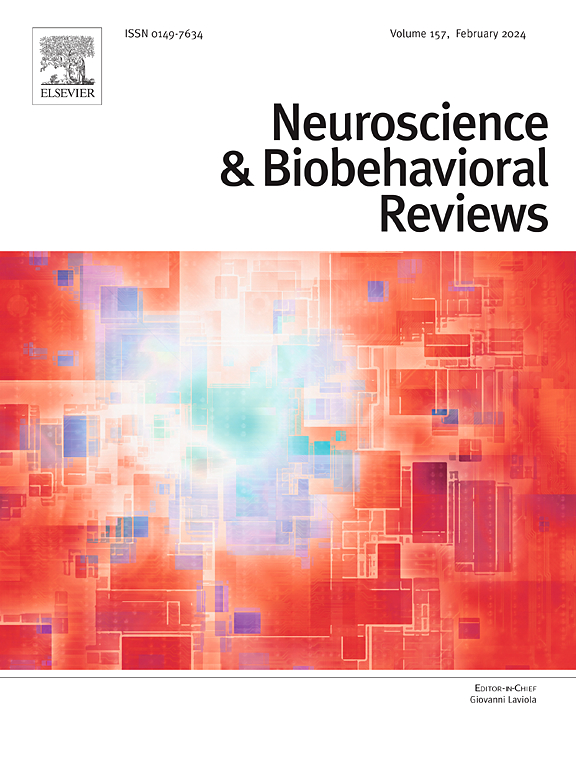Systematic review: Biopsychosocial factors related to attention-deficit/hyperactivity disorder in children/adolescents with Neurofibromatosis type 1
IF 7.9
1区 医学
Q1 BEHAVIORAL SCIENCES
引用次数: 0
Abstract
This systematic review was conducted to provide a comprehensive summary of biopsychosocial factors associated with attention-deficit/hyperactivity disorder (ADHD) in children and adolescents with Neurofibromatosis Type 1 (NF1), and identify key limitations and gaps in the current literature. Systematic literature searches were conducted in Scopus, PsycINFO, Web of Science, PubMed, and ProQuest Dissertations and Theses Global in March 2024. The searches identified 2345 unique articles. Two researchers independently screened articles and extracted data. Inclusion criteria were met by 68 articles. We synthesized results across studies in a narrative format, following the Guidance on the Conduct of Narrative Synthesis in Systematic Reviews. Based on the biopsychosocial model of mental health, we grouped study findings on factors associated with ADHD into broad categories of biological (n = 33), psychological (n = 47), and social factors (n = 13), which were further divided into subcategories. Findings varied across biopsychosocial factors, ADHD-related variables (inattention, hyperactivity, impulsivity symptoms, or ADHD diagnosis), measurement methods, study designs, and statistical approaches. Psychological factors (e.g., executive functioning, IQ) were most commonly studied. Findings revealed consistent evidence for the link between informant-reported executive functioning problems and ADHD, whereas performance-based cognitive measures generally showed no significant associations. Most studies are cross-sectional and have small and nonrepresentative samples. Methodological limitations in previous studies hinder definitive conclusions on biopsychosocial factors associated with ADHD in NF1. Future research should use larger samples and longitudinal or experimental designs, explore understudied biological and social factors, and incorporate new technologies to improve understanding and interventions.
系统评价:1型神经纤维瘤病儿童/青少年注意缺陷/多动障碍相关的生物心理社会因素
本系统综述旨在全面总结与1型神经纤维瘤病(NF1)儿童和青少年注意缺陷/多动障碍(ADHD)相关的生物心理社会因素,并确定当前文献中的主要局限性和空白。在2024年3月对Scopus、PsycINFO、Web of Science、PubMed、ProQuest dissertation and Theses Global进行了系统的文献检索。这些搜索发现了2345篇独特的文章。两位研究者独立筛选文章并提取数据。有68篇文章符合纳入标准。我们按照《系统评价中叙事综合的行为指南》,以叙述的形式综合了所有研究的结果。基于心理健康的生物心理社会模型,我们将ADHD相关因素的研究结果分为生物学(n = 33)、心理学(n = 47)和社会因素(n = 13)等大类,并进一步细分为亚类。研究结果因生物心理社会因素、ADHD相关变量(注意力不集中、多动、冲动症状或ADHD诊断)、测量方法、研究设计和统计方法而异。心理因素(如执行功能、智商)是最常被研究的。研究结果显示,举报人报告的执行功能问题与多动症之间存在一致的联系,而基于表现的认知测量通常没有明显的联系。大多数研究是横断面的,样本小且不具代表性。以往研究的方法学局限性阻碍了对NF1中ADHD相关的生物心理社会因素的明确结论。未来的研究应该使用更大的样本和纵向或实验设计,探索未被充分研究的生物和社会因素,并结合新技术来提高理解和干预。
本文章由计算机程序翻译,如有差异,请以英文原文为准。
求助全文
约1分钟内获得全文
求助全文
来源期刊
CiteScore
14.20
自引率
3.70%
发文量
466
审稿时长
6 months
期刊介绍:
The official journal of the International Behavioral Neuroscience Society publishes original and significant review articles that explore the intersection between neuroscience and the study of psychological processes and behavior. The journal also welcomes articles that primarily focus on psychological processes and behavior, as long as they have relevance to one or more areas of neuroscience.

 求助内容:
求助内容: 应助结果提醒方式:
应助结果提醒方式:


